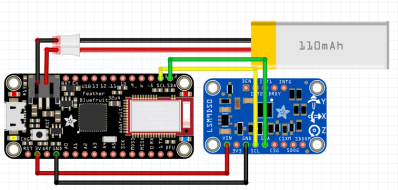As has been made abundantly clear by the advertising department of essentially every consumer electronics manufacturer on the planet: everything is improved by the addition of sensors and a smartphone companion app. Doesn’t matter if it’s your thermostat or your toilet, you absolutely must know at all times that it’s operating at peak efficiency. But why stop at household gadgets? What better to induct into the Internet of Things than 600 year old samurai weaponry?
 Introducing the eKatana by [Carlos Justiniano]: by adding a microcontroller and accelerometer to the handle of a practice sword, it provides data on the motion of the blade as it’s swung. When accuracy and precision counts in competitive Katana exhibitions, a sword that can give you real time feedback on your performance could be a valuable training aid.
Introducing the eKatana by [Carlos Justiniano]: by adding a microcontroller and accelerometer to the handle of a practice sword, it provides data on the motion of the blade as it’s swung. When accuracy and precision counts in competitive Katana exhibitions, a sword that can give you real time feedback on your performance could be a valuable training aid.
The eKatana is powered by an Adafruit Feather 32u4 Bluefruit LE and LSM9DS0 accelerometer module along with a tiny 110 mAh LiPo battery. Bundled together, it makes for a small and unobtrusive package at the base of the sword’s handle. [Carlos] mentions a 3D printed enclosure of some type would be a logical future improvement, though a practice sword that has a hollow handle to hold the electronics is probably the most ideal solution.
A real-time output of sword rotation, pitch, and heading is sent out by the Adafruit Feather over BLE for analysis by a companion smartphone application. For now he just has a running output of the raw data, but [Carlos] envisions a fully realized application that could provide the user with motions to perform and give feedback on their form.
Incidentally this isn’t the first motion-detecting sword we’ve ever covered, but we think this particular incarnation of the concept might have more practical applications.

















I thought about doing this for fencing swords like the foil, epee and sabre many times!
Getting rid of those expensive sensor jackets would be a real plus for the sport.
Off on a wild tangent here. “Everything is improved?” <> I’m open to suggestions on how sensors and a smartphone companion app will improve my horses. Yes, horses.
Not merely the weaponry held by a charging cavalry fighter, but the horse itself. Detectors for loose shoes or impending laminitis? Determination of a horse’s actual age by analysis of DNA telomeres? How might I do these things? What opportunities am I overlooking?
And thus Peter Neilson created the first eFigging device.
My knowledge of horses is limited, but maybe a accelerometer in the legwraps? An uneven gait is an indication something’s wrong with the horse isn’t it?
Measuring even higher orders than acceleration (jerk and snap, i.e. d3s/dt3, d4s/dt4) might be useful. I don’t think anyone’s ever done that, for horses. What transducers can we buy or build?
Enter your comment here…Ugh. Worsepress grabbed my blogname, instead of my real name.
Transhorsenism.
I suppose for riding students, sensors around the saddle/harness could be used to check on their form and such? I dunno though, I’m not of the opinion “Everything is improved….”
Perhaps one worthwhile project could be a method, not unlike the sword-handle gizmos, to give the rider direct feedback on the use of the reins. Riders aspire to have “good hands” but that’s something learned only with difficulty. The novice rider pulls and yanks too much, confusing the well-trained horse.
Putting stress-and-strain sensors into the reins could give immediate feedback to the rider or to the instructor.
Good riders would assume, of course, that the direct feedback from the horse himself was sufficient, and that no other technology was required.
Maybe a GPS module, and then you can measure top speed, distance traveled, etc.? An ECG module and you can measure heartbeat to check for horse exertion?
I did see a job advert for some horse-IoT thing some months ago. Don’t remember the details, as I got forwarded it for laughs (was the usual “we can’t pay you cash, but stock will be $$$ eventually” with a “must like horses” rider (sorry…)).
This would be a great tool for analyzing a golf club swing.
i like the basic idea of this. but the electronics are placed on a spot where they will allways get in the way – at least for kendo swordsmen.
see this pic for reference: http://blackbeltmag.com/daily/martial-arts-philosophy/japanese-martial-arts/how-to-use-the-combat-concepts-of-legendary-swordsman-miyamoto-musashi-in-21st-century-self-defense/attachment/black-belt-photo-sword-grip-476/
fail xD
see this pic for reference: http://blackbeltmag.com/wp-content/uploads/black-belt-photo-sword-grip-476.jpg
I suspect with a little bit of engineering though the electronics can be hidden in the hilt of the katana without interfering with the tang or the balance of the sword too much. For a bokken there wouldn’t be any issue hollowing out the handle slightly to allow for the electronics.
Sure thing. Also a replacement tsuba with builtin electronics would be thinkable for a bokken. The tsuba of a bokken (usually) never touches anything.
The next logical step is to get this code added to a VR online meeting app, and call it Black Sun.
Calm down Hiro ;-)
Awesome! I was looking at doing this myself, for sidesword. The form-factor of this is very neat.
Hmmm, seems to me that the HW is the easy part, the hard part will be doing meaningful analysis in the SW….
He needs something like this: https://www.kickstarter.com/projects/guardyen/tiny-programmable-ble-sensors-that-wont-break-your